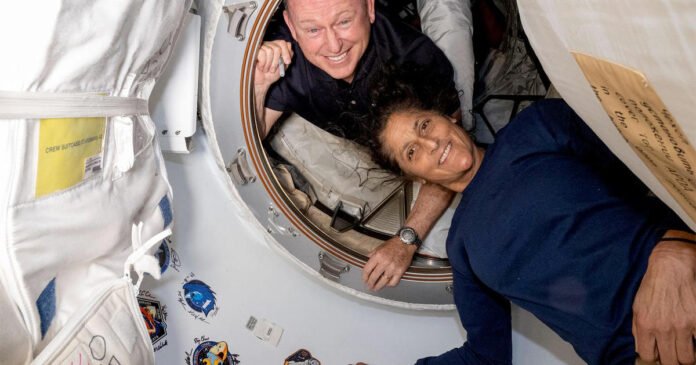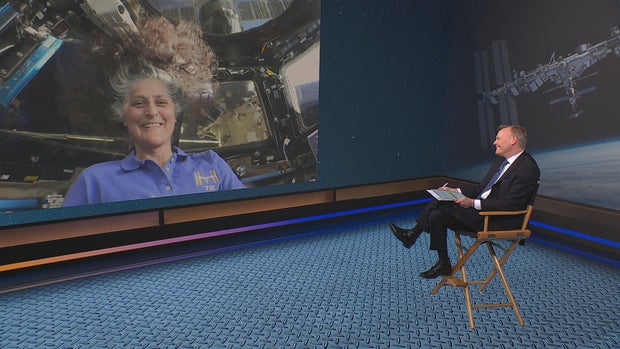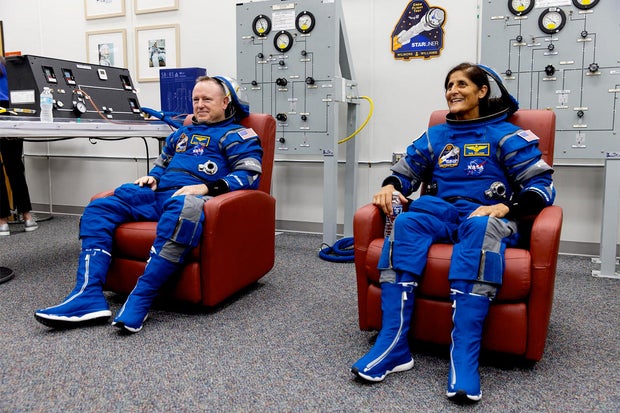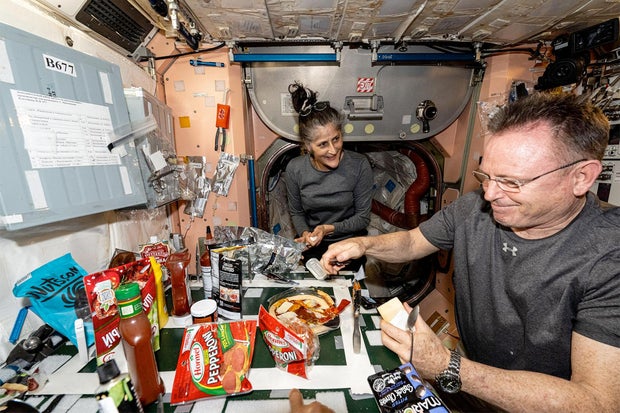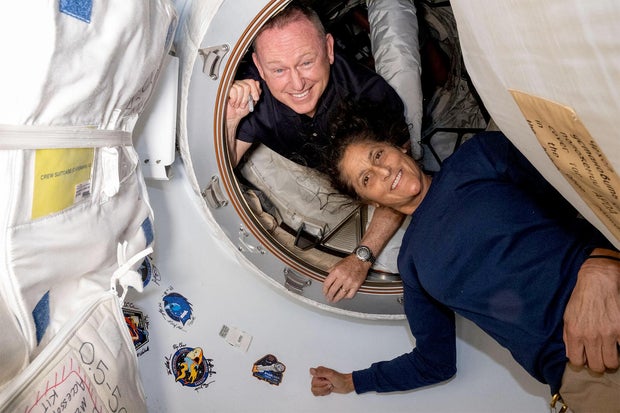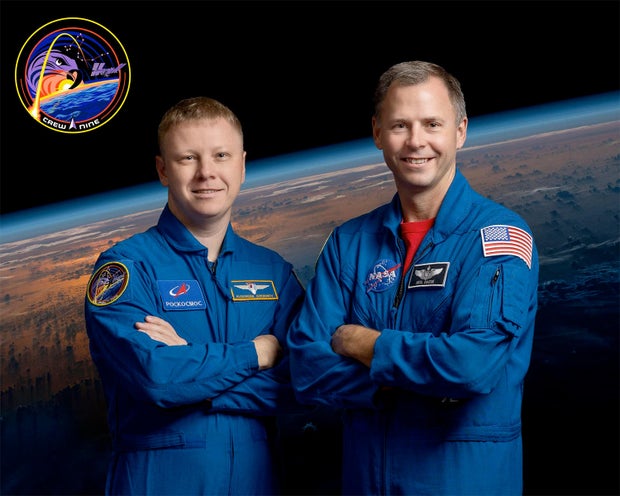Contrary to a recent social media post from President Trump, Starliner astronaut Sunita Williams says she and crewmate Barry “Butch” Wilmore have not been “virtually abandoned” in space, despite a mission that’s been extended from a little more than one week to more than nine months.
“I don’t think I’m abandoned. I don’t think we’re stuck up here,” she told CBS Evening News co-anchor John Dickerson during an in-flight interview airing Friday night. “We’ve got food. We’ve got clothes. We have a ride home in case anything really bad does happen to the International Space Station.
“We’re in a posture … where we have the International Space Station fully manned and doing what the taxpayers wanted, to do world-class science. And so I feel honored, like I said, to be here and a part of the team.”
CBS News
NASA is finalizing plans to bring Williams and Wilmore back to Earth, along with their two space station crewmates, Crew 9 commander Nick Hague and cosmonaut Alexander Gorbunov, around March 19, sources say. That would shorten their extended stay in orbit by about two weeks compared to a previous plan for late March or April.
The slightly earlier trip home would be possible if the next set of station fliers, known as Crew 10, is switched to a different Crew Dragon spacecraft, one that can be ready for launch as early as mid March. The switch is needed, sources say, because work to prepare the original SpaceX ferry ship for its maiden flight is taking longer than expected.
In any case, after a weeklong handover to bring their Crew 10 replacements up to speed on the ins and outs of space station operation, Hague, Gorbunov, Wilmore and Williams would undock and head back to Earth.
They’ll come home aboard the same Crew Dragon that carried Hague and Gorbunov to the station last September, along with two empty seats reserved for Wilmore and Williams’ return.
NASA
Why the mission extended for months
Assuming the dates hold up — and there are multiple variables in play — Wilmore and Williams will have logged nearly 290 days in orbit since their launch June 5 on a mission originally expected to last a little more than one week, the time needed to carry out the first piloted test flight of Boeing’s Starliner spacecraft.
But the Starliner, built as part of a NASA program to develop independent commercial crew ships to ferry astronauts to and from the space station, ran into propulsion problems and helium leaks shortly after launch that prompted weeks and then months of tests and analysis.
In the end, NASA managers decided the risks were too high to bring Wilmore and Williams down aboard the Starliner. Instead, they opted to bring the ship down by remote control, without its crew, and to keep Wilmore and Williams aboard the station until they could hitch a ride home with Hague and Gorbunov at the end of the Crew 9 expedition.
NASA initially planned to bring all four back to Earth in February, but last December, another month was tacked onto the mission because of work needed to ready the Crew 10 Starliner for launch. Sources now say more time is needed to finish that work.
NASA
Trump speaks out on crew’s delay
President Trump last month blamed the Starliner crew’s overall mission extension on the Biden administration, saying in a social media post that he had asked SpaceX founder Elon Musk to “go get” the two “brave astronauts who have been virtually abandoned in space by the Biden administration.” He also named Musk, a billionaire supporter of the Trump campaign, to head the Department of Government Efficiency, or DOGE, which is charged with cutting the size of the federal government.
Musk said in an earlier post on his social media platform X that Mr. Trump had asked SpaceX to get the Starliner astronauts home as soon as possible, adding “we will do so. Terrible that the Biden administration left them there so long.”
NASA’s administrator at the time, Bill Nelson, was appointed by the Biden administration, but the decision to extend the Starliner crew’s mission was made by the agency’s Commercial Crew and International Space Station programs. The plan has been in place since last September when the Crew 9 Dragon was launched with two empty seats for Wilmore and Williams.
As such, there is no need to “go get” the astronauts — their ride home has been docked at the space station for the past five months.
“We don’t feel abandoned. We feel like we’re part of the team.”
In the interview, Dickerson asked Williams about the president’s comments on their mission.
“Trump said you and Butch Wilmore, who is your Starliner crewmate, had been — this is the president’s words — ‘virtually abandoned,'” Dickerson asked. “Do you feel abandoned up there, commander?”
“I don’t think those words are quite accurate,” Williams replied. “Both Butch and I have lived up here on the space station before. We know how NASA and our commercial partners work together. So we expected that we would be up here for a little while.
“We’re part of something bigger than ourselves. We’re part of the International Space Station, and we have obligations to our international partners to do science and exploration while we’re up here. So yeah, we knew this was going to happen, so no, we don’t feel abandoned. We feel like we’re part of the team, and that’s a huge honor.”
NASA
Asked why the Crew 9 Dragon couldn’t return to Earth sooner, given that it’s already docked at the station, Williams said that would leave the station with a single U.S. crew member aboard, Don Pettit, who was launched to the station last year with two cosmonauts aboard a Russian Soyuz spacecraft.
With only a single U.S. astronaut aboard to respond to emergencies, operate power, life support and other systems in the NASA segment of the station, high-priority research would grind to a halt. Standard practice is for NASA to launch a replacement crew about a week before the outgoing crew’s departure for an orderly handover.
“Sure, it could have taken us home, but that leaves only three people on the space station from the Soyuz crew, two Russians and one American,” Williams said. “And the space station is big, it’s a building, it’s the size of a football field.
“Things can go wrong, and you need to be able to fix it, either inside (or) outside, and so having additional people to be able to do that, that capability, is really important.”
NASA
NASA has tentatively decided to switch the Crew 10 fliers — commander Anne McClain, pilot Nichole Ayers, Japan’s Takuya Onishi and cosmonaut Kirill Peskov — to a different Crew Dragon to avoid adding even more time to Crew 9’s already extended mission.
Crew 10 is expected to be assigned to a Crew Dragon that had been earmarked for a commercial flight to the station, a mission known as AX-4 that was booked by Houston-based Axiom Space. That non-NASA crew would instead use the original Crew 10 Dragon later this spring.
NASA would not comment on the plans. A spokeswoman said “we’re not able to confirm any details reported on Crew 9 return at this time. We are working through coordination of forward plans for the agency’s Commercial Crew Program missions with its various stakeholders. We will share more information as soon as we can.”
For her part, Williams said she just wanted “the right decision to be made, in the best interest of all of us, of Crew 10, of course, and us. I’m happy either way. Eight days turned into a couple more months than that, a couple more months, whatever, it doesn’t really matter. The right decision just has to be made.”
Read More: NASA astronaut Sunita Williams says “we don’t feel abandoned” or “stuck” as space mission


